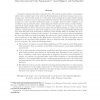Free Online Productivity Tools
i2Speak
i2Symbol
i2OCR
iTex2Img
iWeb2Print
iWeb2Shot
i2Type
iPdf2Split
iPdf2Merge
i2Bopomofo
i2Arabic
i2Style
i2Image
i2PDF
iLatex2Rtf
Sci2ools
WINE
2005
Springer
2005
Springer
A Graph-Theoretic Network Security Game
Consider a network vulnerable to viral infection. The system security software can guarantee safety only to a limited part of the network. Such limitations result from economy costs or processing costs. The problem raised is to which part of the network the security software should be installed, so that to secure as much as possible the network. We model this practical network scenario as a non-cooperative multi-player game on a graph, with two kinds of players, a set of attackers and a protector player, representing the viruses and the system security software, respectively. Each attacker player chooses a node of the graph (or a set of them, via a probability distribution) to infect. The protector player chooses independently, in a basic case of the problem, a simple path or an edge of the graph (or a set of them, via a probability distribution) and cleans this part of the network from attackers. Each attacker wishes to maximize the probability of escaping its cleaning by the protect...
| Added | 28 Jun 2010 |
| Updated | 28 Jun 2010 |
| Type | Conference |
| Year | 2005 |
| Where | WINE |
| Authors | Marios Mavronicolas, Vicky G. Papadopoulou, Anna Philippou, Paul G. Spirakis |
Comments (0)

